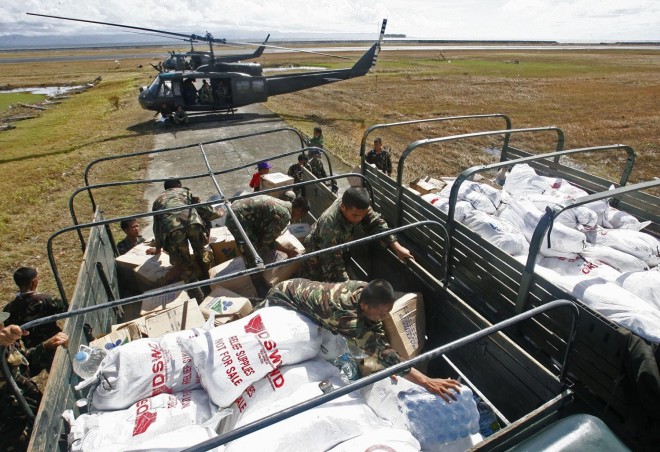
Philippine Army soldiers load water and relief goods at a military truck for distribution to Super typhoon Yolanda victims at the Tacloban Airport.RAFFY LERMA/INQUIRER
LEGAZPI CITY, Philippines—A seven-kilometer stretch of the Maharlika Highway leading to Matnog Port in Sorsogon could now be the busiest road in the Bicol Region after various disaster agencies ratcheted up the rollout of relief convoys en route to devastated Visayan provinces by land.
Hundreds of trucks loaded with relief goods and passenger buses bound for provinces on the islands of Samar and Leyte—the worst-hit areas—were lined up along this stretch of highway leading to Matnog Port on Friday, said Rosenda Sumagaysay, Philippine Ports Authority regional port manager.
Sumagaysay said in a telephone interview that tons and tons of relief goods kept arriving at Matnog, foming a long line of cargo trucks and passenger buses from Metro Manila waiting for their turn to get on a limited number of roll-on-roll-off ferries for the sea crossing to the port of Allen in Northern Samar for their onward journeys on land to various places on Samar and Leyte.
She said the long line of stranded trucks and passenger buses along the highway could be attributed to the lack of RORO vessels to accommodate them.
Sumagaysay said there were only eight such vessels plying the Matnog-Allen route twice daily that could ferry 15 cargo trucks and 15 buses per trip.
The bus trip from Manila to Matnog takes up to 12 hours and crossing the San Bernardino Strait on the ferry to Allen takes 45 minutes.
The eight vessels operating in Matnog are owned by Montenegro Lines, Philippine Harbor Ferries, 168 Shipping Lines Corp., Santa Clara Shipping Lines and Peñafrancia Shipping Lines.
Sumagaysay said she has been personally supervising port operation since Saturday, when, because of the influx of trucks bearing relief goods, the port began operating 24/7.
She said she has directed her port employees to give top priority to cargo trucks bringing relief goods to Samar and Leyte provinces due to the urgency of the typhoon victims’ needs.
Sumagaysay said she has designated Bulan Port, also in Sorsogon, as a holding area for incoming cargo trucks and passenger buses while waiting for the cue to board the RORO vessels in Matnog as one way of decongesting the Maharlika Highway.
She also asked the owners of the shipping lines to dispatch additional ferries to accommodate the traffic buildup.
Sumagaysay said she planned to open Bulan Port for additional ferry crossings from there.
While thousands have been scrambling to leave Samar and Leyte after the supertyphoon devastated these provinces, hundreds of other people were struggling to take the next trip out of this port so they could return to their families in these provinces.
Lorelyn Marteja said had been traveling for almost two days now from Laguna so she could see her mother and sibling in Burauen, Leyte.
“I’m worried that they might run out of food to eat,” she said, her face creased with worry.
She boarded a ship to Samar with about 600 people similarly situated on Friday.
Marteja’s family was among those who survived the supertyphoon but they have yet to receive relief assistance.
At the port, around 50 trucks containing relief food packs were forced to wait in line to board the very few RORO ships to the Visayas.
Some 25 more Army trucks carrying relief goods were likewise waiting at the port, said Maj. Angelo Guzman, Armed Forces of the Philippines deputy information officer, who was waiting in one of the trucks.
Fernando Lim, who was going home to Calbayog, Samar, worried about his brother and relatives in Tacloban City.
He considered himself lucky he was able to secure his family, although looting was also a problem in his town.
“The rich were lucky with their big houses and generators,” he said. “They were safe from the whistling wind,” he added.
The Department of Social Welfare and Development regional office in Bicol, which has been tasked by its national office to assist in relief operations in Eastern Visayas, has so far delivered 13,156 family food packs since they started operation on Monday and an additional 4,000 food packs donated by the town of Baao in Camarines Sur, said Arnel Garcia, regional DSWD director.
Garcia said DSWD-Bicol has been tasked to produce and help distribute 20,000 family food packs daily for a period of 30 days.
DSWD-Bicol commissioned the Office of Civil Defense (OCD)-Bicol and Albay provincial government for help in producing the emergency food packs.

